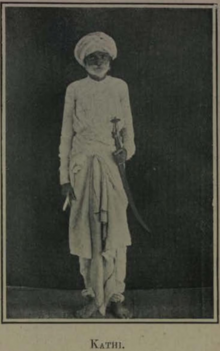Kathi people

The Kathi people is a small group of clans found in the peninsular Kathiawar (historically called Saurashtra) of Gujarat, western India. It was from the Kathis that the Maratha Empire and later the British Raj renamed the Saurashtra as Kathiawar as the Kathis were prominent there during the 17th-18th centuries. According to A. M. Shah, Kathis are a peasant caste.[1]
Their kuladevatā is the Sun. According to tradition, a Kāṭhī called Vāloji fled from Pāvāgaḍh. He defeated Jām Abdā of Thān with the help of the Sun god, and in return Vāloji repaired the sun temple on Kandolā Hill (originally built by Māndhātā in Satya Yuga). Vāloji's daughter Sonabāi became the priestess of the temple, and married Vālerā Jālu. Sonabāi's descendants, known as Bhagats, form the main sun-worshipping strand of Kāṭhīs.[2]
The Kathis practiced the partition of territory upon a rulers death, in which his territory would be carved out among his sons. However, the British encourage the practice of primogeniture, in which a ruler's territory would be completely inherited by his eldest son (or whomever was next in succession). The British favored this practice because it was easier to maintain control over a few large states rather than hundreds of small ones. However by the late 1920s, only a few Kathi rulers had adopted primogeniture.[3][4][5]
History[edit]
The sun-worshipping Kāṭhīs, who lent their name to the region of Kathiawar, are documented as serving under the Cūdāsamās during the eleventh century. Previously under the authority of the Sūmrās of Sind, they were compelled to escape Sindh and seek sanctuary with the Vālā chieftain in Saurashtra. During this era, the Kāṭhīs appeared to be marginalized, as the Vālā leader was reportedly ostracized from his caste after dining with them, leading to his deposition from kingship by his siblings. Subsequently, he allied himself with the Kāṭhīs and, together, they conquered various territories, including the Than-Chotila area, from the Soḍhās. Offspring of the Kāṭhī–Vālā coalition established three Kāṭhī tribes named after them. They also formed marital bonds with indigenous clans like the Dhāndhal Rāṭhoḍs and Jhālās. Renowned for their prowess in combat, they were esteemed as premier cattle rustlers and adept horse breeders, producing some of India's most resilient equines. Kāṭhīs often engaged as military aides and did not ascend to a prominent status akin to Rajputs. The Kāṭhīs were expelled from Sind by the Samma Jām Abdā. By the fifteenth century, various branches of the Kāṭhīs also settled in Kachchh, where they established the kingdom of Pavārgaḍh near Bhuj. According to one tradition regarding their origins, they were reputedly brought to Gujarat by the legendary figure of the Mahābhārata, Karṇa, due to their unmatched expertise in cattle rustling. Subsequently, they were displaced from Kachchh by the Jāḍejās and relocated to the Than region.[6]
Subdivisions[edit]
There are several branches of Kāṭhīs, including Vaḷā, Sakhāyat, Khumān, Khācar, and Auratiya. The Vaḷā Kāṭhīs were formed when a Vaḷā Rājput married a Kāṭhī woman. The Auratiyas were formed on another occasion when Rājputs married Kāṭhi women. Historically, Kāṭhī women were known to marry Rājput men; however, marriages with Āhirs and Bābariās were more common.[7]
Classification[edit]
Kathis are currently classified as Other Backward Class in the central list of Gujarat.[8]
Culture[edit]
Kathi people are horse lovers and keep Kathiawari horses, which are known worldwide.[5][need quotation to verify][9]
References[edit]
- ^ Shah, Arvind (1988). Division and Hierarchy: An Overview of Caste in Gujarat. Hindustan Publishing Corporation. p. 4.
- ^ Bhatt, P. N. (1953). "The Sun-Cult in Gujarat and Saurashtra". Proceedings & Transactions of the All India Oriental Conference: Seventeenth Session, Ahmedabad. All India Oriental Congress. p. 435.
- ^ McLeod, John (1999). Sovereignty, Power, Control: Politics in the State of Western India, 1916-1947. Brill. pp. 13, 196, XI.
- ^ Karve, Irawati (1990). Kinship Organization in India. Munshiram Manoharlal. p. 172.
- ^ a b International Encyclopedia of Horse Breeds Page 251-252
- ^ Sheikh, Samira (2009). "Pastoralism, Trade, and Settlement in Saurashtra and Kachchh". Forging a region: sultans, traders, and pilgrims in Gujarat, 1200-1500. Oxford University Press. pp. 101–128. ISBN 9780198060192.
- ^ Desai, I.P (1988). "A Critique on "Division and Hierarchy"". Division and Hierarchy: An Overview of Caste in Gujarat. Hindustan Publishing Corporation. pp. 60, 134, 135.
- ^ "Central OBC list, Gujarat". National Commission for Backward Classes. Retrieved 13 July 2021.
- ^ , Bonnie Hendricks (1995). International Encyclopedia of Horse Breeds. Norman: University of Oklahoma Press. ISBN 9780806127538. Pages 251–252.
6. Books of The History of Kathiawad from the Earliest Times by Captain Wilberforce-Bell
